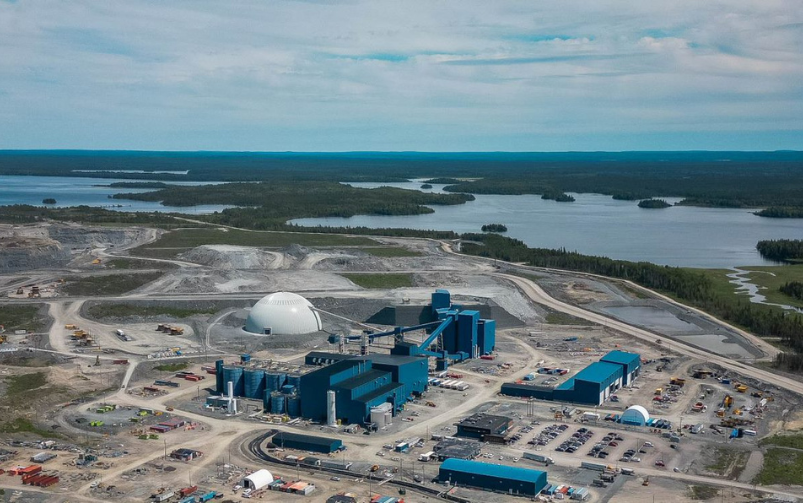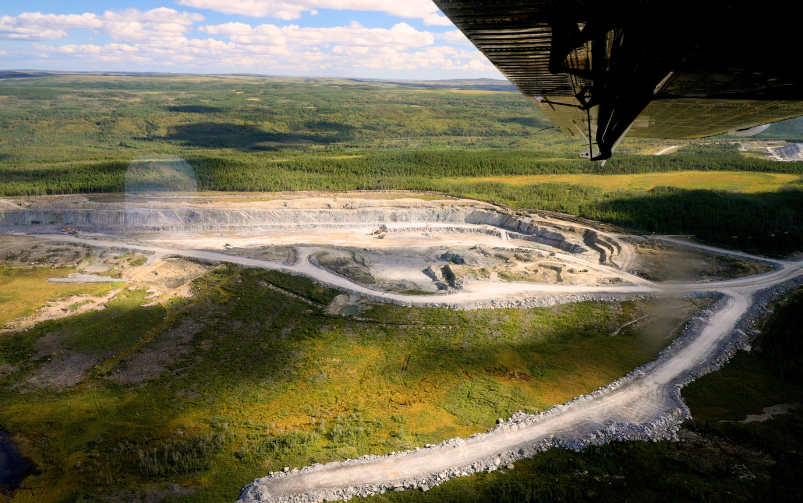Tim Day, asset president for Western Australia Iron Ore at BHP; Tania Archibald, chief executive of Australia Steel Products at BlueScope; and Simon Trott, chief executive of Rio Tinto. Courtesy of BlueScope.
Welcome back to your weekly mining news recap, where we catch you up on some of the news you may have missed. This week’s headlines include New Gold’s three-year plan to boost gold production, Mexico’s president’s call for a ban to open-pit mining, and Electra Battery Materials’ $5 million grant.
At least nine people were trapped when the wall of a heap leach pad failed and sent an estimated 10 million cubic metres of material flowing down slope at the Çöpler gold mine in Turkey on February 13. The TSX-listed miner SSR Mining has an 80 per cent stake in the mine. Rescuers are searching for the workers through the cyanide-soaked soil of the mine, and there are concerns the cyanide could contaminate the watershed. The Union of Chambers of Turkish Engineers and Architects said that it had previously issued warnings about a potential disaster that ultimately went ignored and is calling for the mine to be closed, as reported by Al Jazeera.
The Canadian government plans to reduce the amount of time it takes to construct new critical mineral mines by almost a decade thanks to what it promises will be a faster permitting process, as reported by Reuters. The government plans to do this by boosting funding to the regulatory agency to help remove paperwork backlogs and by simultaneously running permitting and environmental assessment processes.
Major iron ore producers BHP and Rio Tinto have partnered up for the first time on a downstream project with BlueScope Steel, Australia’s largest steelmaker, to develop a green steel pilot project that could significantly reduce carbon emissions for global steelmakers relying on Australia for iron ore. A pre-feasibility study for the project is being conducted and is planned to be completed by the end of this year. If the project progresses, it is expected to begin operations sometime in 2027.
The Electra Battery Materials cobalt refinery in Temiskaming Shores, Ontario, was given a $5 million grant from the federal government, as reported by CBC News. The funding from the Federal Economic Development Initiative for Northern Ontario follows Electra’s announcement last August that the company would slow construction of its battery materials park project due to a lack of funds. In order to complete the project, the company is seeking to secure roughly $80 million in funding.
A three-year plan to boost gold production by 35 per cent has been released by New Gold, as reported by The Northern Miner. If achieved, this plan would see the company’s gold production increase from last year’s total of 321,178 ounces to 410,000 to 460,000 ounces in 2026.
Andrés Manuel López Obrador, Mexico’s president, has called for a ban on open-pit mining in the country, as reported by Mining Technology. His proposal cited concerns over environmental damage as a reason for the ban. Of the Mexico’s 250 mines, 97 are open-pit operations. His proposed change to the constitution would formalize what has been a de facto ban on open pit mining. His government has not permitted any open pit projects since it took power in 2018.
Andrew Forrest, the executive chairman of Fortescue, declared that carbon capture is not a solution to the energy transition while speaking at the 50th anniversary meeting of the International Energy Agency in Paris, France, as reported by Reuters. He stated that carbon capture technology is a “complete falsehood” and will not reduce global CO2 emissions from fossil fuels in any meaningful way. Forrest suggested that in order to drive capital, clear disincentives for what is causing harm and incentives for what is doing good are needed. The iron ore producer announced last year that it is diversifying into green technology and sustainable energy projects.
SRK Consulting’s Adrian Dance spoke with Ailbhe Goodbody about the need for improved mine-to-mill optimization in the December/January issue of CIM Magazine. Dance is part of a team at SRK Consulting that has developed sensor testing procedures and has acquired a laboratory-scale batch X-ray transmission (XRT) sensing unit to carry these out. These tests can be used alongside crushing and screening in order to assess the potential for preconcentration of heterogenous ore deposits, which can later be applied to scoping or prefeasibility studies.
Panasonic Energy and General Motors (GM) have committed to multi-year offtake agreements for active anode material from Nouveau Monde Graphite (NMG), which would account for roughly 85 per cent of NMG’s phase two fully integrated production. In addition to the offtake agreements, an aggregate US$50 million investment from Panasonic and GM will be used to advance NMG’s development of the second phase of its Matawinie mine and Bécancour battery material plant, which are both located in Quebec.
We also have some year-end results and production results this week, including:
Barrick Gold produced 4.05 million ounces of gold in 2023 at an all-in sustaining cost of US$1,364. The company also produced 420 million pounds of copper at an all-in sustaining cost of US$3.12 per pound. The company reported $1,459 million in earnings before adjusted interest, taxes, depreciation, and amortization (EBITDA).
McEwen Mining announced production results that were within its guidance, producing 154,600 gold equivalent ounces in 2023.
Agnico Eagle produced 3,439,654 ounces of gold in 2023 at an all-in sustaining cost of US$1,179 per ounce.
Iamgold produced 465,000 ounces of gold for the year at an all-in sustaining cost of US$1,783 per ounce. The company’s EBITDA from its operations amounted to US$366.6 million for the year.
Other reporting companies included Kinross.
That’s all for this week. If you’ve got feedback, you can always reach us at editor@cim.org. If you’ve got something to add, why not join the conversation on our Facebook, Twitter, LinkedIn or Instagram pages?




